Education marketing aims at building awareness about your institution and rapport among prospective students to fill seats faster.
With a growing number of colleges and now digital universities, it has become even more difficult to reach and grab the attention of prospective students.
Amidst this, how do you drive enrollment? In this article, we take you through the process of:
- Building a plan for education marketing
- Identifying and activating marketing channels
- Selecting tools that facilitate marketing activities
- Automating your marketing efforts and measuring the outcome
We will also discuss best practices to follow and highlight the impact these strategies and tools have on the student conversion ratios for an educational institution.
Building your Education Marketing Plan
You might have heard this quote – Failing to plan equals planning to fail. So, right off the bat, you need to set your goals and tick off the checklist to maximize your returns.
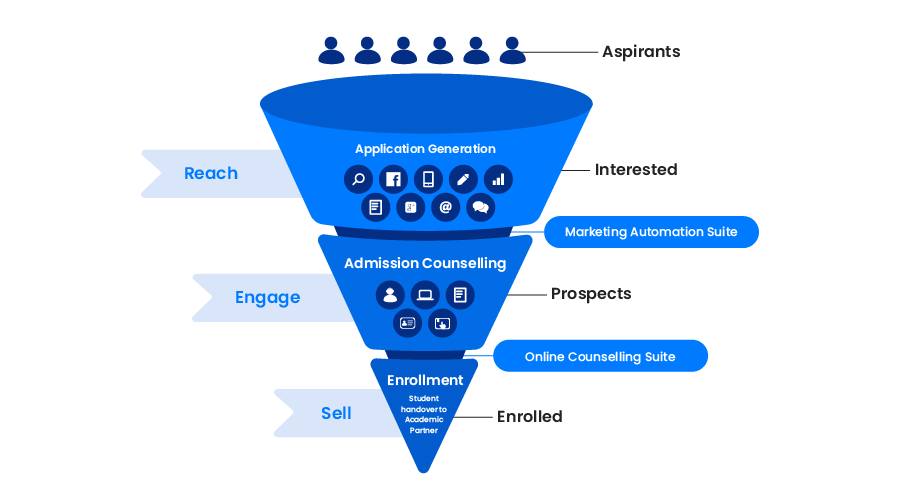
Here are a few pre-requisites for creating an education marketing plan:
1. Know which students you want to target
It is obvious that you would be marketing to students, but you need to be more specific than that. Ask questions like –
- What skills are required for students to take my courses?
- What should be their ideal educational background?
- What are their interests and career goals? And what future do they foresee?
- How does my course benefit them?
- Which demographic can I cater to?
These questions will help you create student personas you can reach out to which will directly impact your channels, messaging, budgets, and reach of your activities.
2. Build your content and messaging to attract your student personas
After identifying your target personas, you can start collating content that will resonate with your audience. This could mean infographics, video testimonials, student interviews, campus tours, identifying brand ambassadors, reaching out to corporate partners, and more.
“Young counsellors are present on more of the platforms where our target audience is. As a small university, we trust the youngsters and go to the students where they want to interact and want to be heard.”
Matthew Zonis, Director of Marketing & Recruitment, Drew University
This is a crucial step as it will set the tone for engaging with prospective students. And this stage that will have multiple rounds of iterations while you are trying to perfect the pitch.
3. Assign targets to your education counsellors
Now that you have resources ready for your admission officers, you need to assign enrollment targets to them. These can be weekly, monthly, or quarterly targets. You’ll also need to define the timelines for converting students, benchmark quality conversations, etc. based on predicted inquiry-to-enrollment rates.
Ask questions like:
- What are the number of students that will enrol this season?
- Do I have learnings from historical data?
- How many prospects should I reach out to?
- How long does it take for me to convince a student to choose my university?
4. Identify and activate channels of communication
The target is set. You know what is expected. Now you need to identify how to disseminate your message and through which channels. This depends on how any student would approach you or how they would discover you.
According to a recent LeadSquared survey, 54% of higher education institutions had 2 to 4 active channels for marketing.
The 2 most obvious channels would be your online and offline storefronts which is your website and campus. This is where the student will approach you. You can build on-campus kiosks, attend student recruitment fairs, organize virtual campus tours to interact with and resolve any queries that they might have regarding your courses.
“All traffic should normally lead to the website to ensure better conversions and a representation of your unique brand. You can do so much with it through landing pages, interactive chat, and more. You need to understand what your audience needs and build your brand & vision around it. Consistency in brand, messaging, and identity is key in order for a strong recall and to build trust.“
Katya Nyangi, Director of Marketing – Strategy & Outreach, African Leadership University
With paid promotions, emailers, WhatsApp, social media, you can get to entice them to consider you through tailored communication. Here is where they get a chance to discover you. You will need to identify channels of distribution like onboarding partners, student ambassadors, working with influencers, gathering online reviews to build trust in the value you provide.
The key is to identify the channels that work for your target audience and use it well.
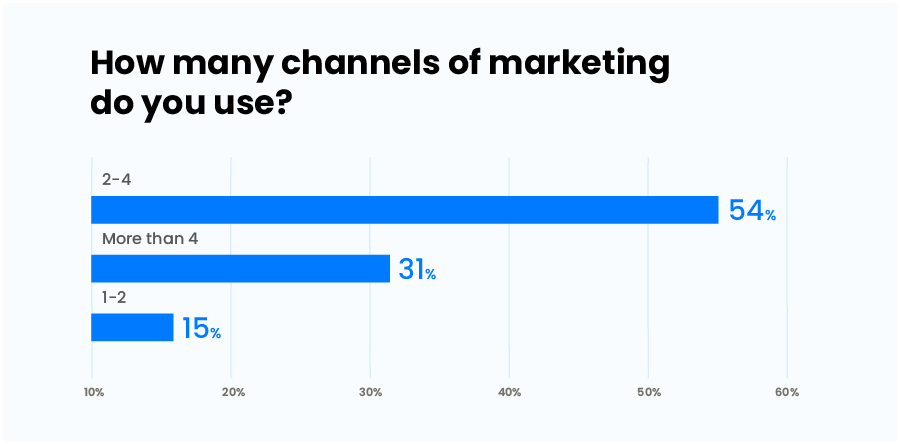
5. Stay on top of their mind by sending personalized messaging
How can you ensure that they choose you? By approaching them at the right time with the right message and through the right channel.
One way to achieve that is through remarketing. You show relevant ads to students who come across your website or dropped an inquiry.
Another way to do that is by calling them up as soon as they fill out an inquiry form or download a brochure. Speed-to-lead is an important metric in education marketing. How soon you’re able to reach out to a student who inquired through your website or ad is an important factor that determines whether they’ll enroll in your institution or not.
6. Double-down on marketing activities that work
Once you start getting noticed, evaluate the channels, messaging, and persona that works. Start seeing patterns throughout the journey of your prospect. This will help you identify and streamline the activities that work best.
Top education marketing channels to drive student engagement
Earlier word-of-mouth and proximity were the major factors that helped to engage with prospects. Now the world revolves around screens, and you need to be sure to pop through the right window.
Here are a few education marketing channels you can use to engage with your prospects.
1. Email marketing
According to research, if you invest $1 in email marketing it will yield a return of $36. Because of this reason 34% of businesses invest on email marketing to engage with their prospects. These facts alone should be enough to probe you to activate this channel for your marketing efforts.
“We can send many engaging campaigns by adding different forms of graphics. It is easy to use due to its drag-and-drop functionality. We’ve also noticed higher opens as emails don’t land in junk much.”
Chetna Ahuja, Creative Head, LearnBay
But besides the numbers, this channel is highly valued due to its reach, convenience, and influence it provides. It allows you to make a personal connect with the reader, to probe your desired action, and share information in methodical manner.
Best practice:
Measure your campaigns based on the action you want them to take. For example, if you want your prospects to know your course offerings, catalogue downloads/page visits should be metric to measure the performance of your campaign.
Top 3 email marketing tools:
- LeadSquared – Basic plan starts from $35/month for 10,000 contacts
- MailChimp – Basic plan starts from $14/month for 6,000 contacts
- Sendinblue – Basic plan starts from $25/month for 10,000 contacts
2. Tele-marketing
This is where you can drive detailed conversations with your prospects. This channel helps you truly personalize your offerings by understanding your prospects’ needs. When a prospect fills out a form on your website, it indicates curiosity. On the phone, you get the opportunity to take the next step.
According to Time Doctor, 59% of prospects prefer to resolve queries and ask questions on live calls. Calling allows you to help students choose the best course and immediately answer any questions they might have like choosing the right major to financial aid.
Best practice:
If it is an incoming call, always ensure that it is answered. Have a call-back option, if your agents are busy,. Don’t have a rehearsed speech delivered in a monotone while approaching the student. Have a dialogue and understand the student’s need.
Top 3 tele-marketing tools:
- Ozonetel – Inbound calls, missed calls and voice mails automatically added in the tool
- Exotel – Capture all your inbound phone calls, missed calls and voicemail inquiries
- CallRail – Capture all your inbound phone calls, missed calls and voicemail inquiries
3. Messaging services
Text and message app marketing has grown popular due to a few facts – 90% of messages are opened within 3 minutes and unlike email, it has a multi-generational appeal. This is important for educational institutions as they reach out to parents and students alike.
With messaging, you get a chance to be more creative and the reader has the entire context in the same window. It allows you to hold multiple conversations at the same time, sends information in different media options, and engage with the prospect in close to real-time.
Best practice:
Text messaging might be less intrusive than calling them, but if you spam them with too many promotional ones, the chances of you getting blocked are high. It is better to get them engaged through other channels and then use messaging to build rapport.
Top 3 text messaging services:
- GupShup – Whatsapp messaging service
- Haptik – AI-driven conversational messaging
- TextNation – Bulk SMS service provider
This is the channel that changed the game for educational institutes. Before social media, your reach was dictated by the proximity of your campus. Now you can not only reach millions but offer them courses where the need to come to campus is not necessary.
Check out how James Madison University used social media to showcase their campus:
Besides your website, this is the channel that can give a personality to your brand. You can share stories, build a community, take feedback, and most importantly get reviews. 93% of prospects say that online reviews have an impact on their decision.
Best practice:
Whether it is organic content, or you run ads, add a recall value. If your prospects can identify you even before they read the message, it will build trust and urge them to take the desired action much faster.
Top 3 social media marketing tools:
- LeadSquared – Connect and manage all your leads coming in from social media apps
- Sprout Social – Manage all your social media content on one platform
- Buffer – Build a social media calendar and automate publishing
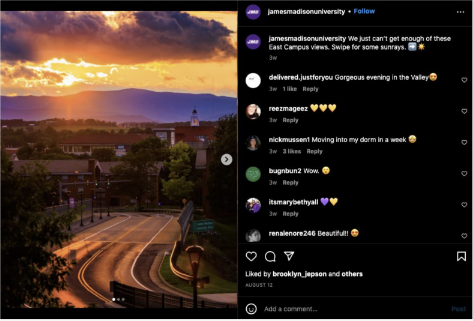
5. Website Chat
As mentioned earlier, website is your online storefront. Your prospects come for a visit, peruse what you have to offer, and then share what they are interested in or ask questions. Service Bell shared that 41% of prospects prefer live chat support over phone or email.
It has the second-highest rating in improving student experience. So, you can not only impact decision-making but also move the needle in your favor by providing a seamless experience.
Best practice:
Having a bot to answer frequently asked questions is a great time-saving tactic. But also ensure that your prospect can get in touch with your counsellors by taking minimum efforts.
Top 3 chat bots for education websites:
- Chat360
- LiveChat
- Zopim
So, these are different marketing channels that work well for higher education institutions.
But the success of your marketing campaigns lies in how well you use these channels. For instance, you may be able to generate inquiries, but can you connect with them immediately? Do you rely on your gut instincts while selecting a marketing channel or check conversion metrics?
The solution is to use a unified and automated system to send out campaigns, collect inquiries (leads), and track the journey henceforth. Let’s dive deeper into automating your education marketing campaigns.
Practical Education Marketing Tips to Build Visibility for your Institute
We recently hosted Matthew Zonis, Katya Nyangi, and Janet Machuka for a webinar on education marketing strategies. Here is a list of practical tips that can help you elevate your marketing efforts.
- Use Youtube as a marketing channel
Change the way you interact with students on social media. Publish videos, interviews, class recordings in order to enable a larger student-base to learn from you. - Introduce skill-based courses
Market a course that teaches students to be ready for future jobs thereby focusing on a skill-based curriculum rather than a knowledge-based. - Build student communities
Have your existing students build communities or groups to interact with other students. This results in the prospective student to get to know about your institution from someone they trust. - Research on how students view your institution
Social media is a powerful channel because you can understand the impact your voice creates, and engage with the people that look up to you. It’s the fastest way to understand and listen to what your target audience is looking for. - Encourage transparency between marketing and admissions teams
When the marketing and recruitment teams communicate with each other thus building a transparent process. Meet regularly to share important updates on what’s in the pipeline regarding new initiatives, new pitches, new messaging. This makes it easy for us to understand that the 20% students that did sign up were the key people we were looking for. - Use technology to automate tasks
Key to leveraging technology is to set up automated communication, track trends to take corrective action early-on, and it also creates a great opportunity to collaborate. - Improve personalization through technology
Tech has helped us nail personalization in a smarter way. We are able to send out multiple campaigns and improve engagement levels with personalized messaging.
You can view the recording of the session here –
Automating your Education Marketing Efforts
No matter how many channels you activate to reach your prospects, the end goal should be reaching them as soon as possible. When your prospects either reach out to you or they engage with your content, it is important for you to reach out to them in almost real-time, every single time.
That is where automating your efforts elevates your communication game.
“It is difficult to have multiple tools to build different processes. It can get expensive as well. So choose a tool that is well-integrated, shares information, and help multiple teams to work more productively.“
Janet Machuka, Founder, ATC Academy
Here are a few strategies to implement marketing automation.
1. Set up sequences for your marketing messaging and emails
Only 3% of prospects are ready to buy while the rest 97% need to be nurtured further before they make the decision. And that is when you can utilise sending out automated sequences of emails or messages.
LeadSquared’s email automation helps you segment and target specific prospects to send out your nurture sequences.
Helpful resources: Higher education email templates, Education drip campaigns
2. Trigger activity-based responses
What if the prospect has visited your course page but hasn’t filled in an enquiry yet? Your counsellors can know the exact course page and build conversation around the same on their first interaction. So, you are no longer having conversations in the dark.
You can also trigger action-based automations like automated follow-up reminders to counsellors or welcome emails to prospects that have shown interest. This enables you to communicate in real-time across channels.
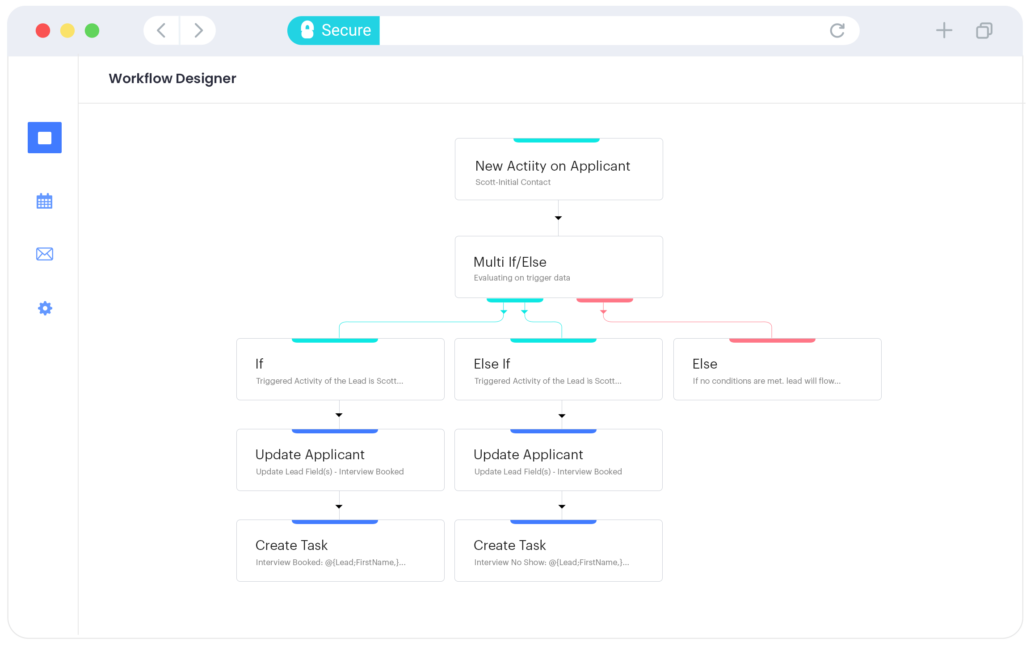
3. Chatbot automation
As mentioned earlier, there are lot of repetitive inquiries coming in through website chat. Common queries like fee structure, financial aid, course pre-requisites, etc. Having a dedicated team to answer those queries compromises the efficiency of the team.
Choosing a chatbot automation tool that enables you to have AI-conversations for repetitive queries increases the efficiency of your counsellors so that they can spend more time in having conversations with high-intent prospects.
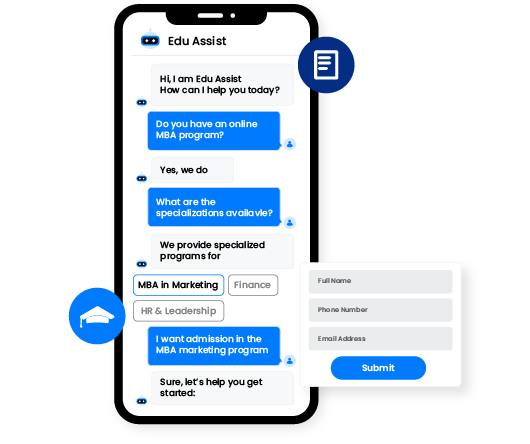
4. Telephony automation
The volume of inquiries that pour in daily for educational institutions is high. It is not possible that every call is answered. So, how do you ensure high-intent calls are not missed out? Like AI-bots you can also have AI-agents that connect and engage with all the students that call.
Besides answering calls, it is also important for your counsellors to optimise their calling times. Using auto-diallers, automated lead distribution, your counsellor productivity can be improved as they will be reaching out to the right prospects in a shorter duration.
You’ve identified your channels, set up the necessary automations, and have started reaching out to a higher volume of prospects. It is equally important to understand the outcome of your efforts. You need to track, optimise, and evaluate the impact it has on enrollments or student experience.
We asked over 300 enrollment counsellors for some of the important KPIs they measure. And this is what they had to share:
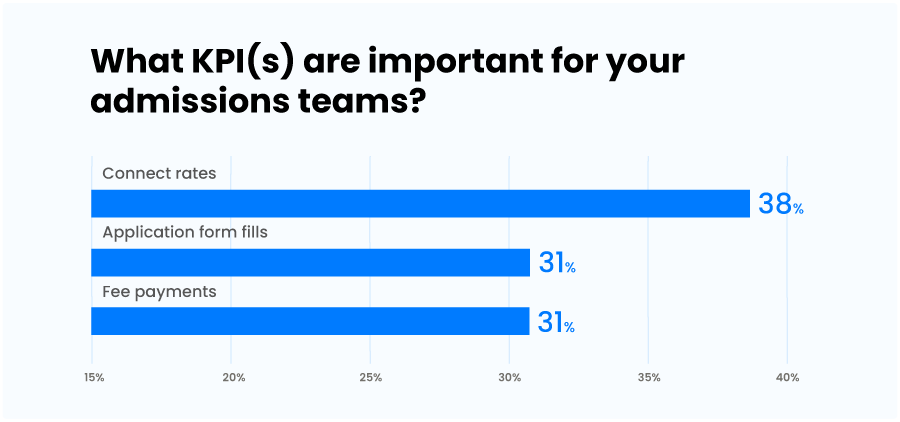
Channel-specific KPIs you can track to quantify the quality of engagement
- For emails and text messaging:
Your open rates, clicks, and replies can be the decisive factor to learn how your prospects are interacting with your content.
Higher opens = Good subject lines
Higher clicks = Engaging content
Higher replies = Good CTAs
- For calls:
The call duration, number of calls connected, daily calls made per counsellor can help you understand whether telephony works for you.
Lengthier calls = Increased chances of conversions
Higher number of calls connected = Higher prospect reach
More calls made per counsellor = Increased counsellor productivity
- For social media:
Paid ad performance depends on multiple factors – the volume of inquiries, conversion rates, and costs incurred to acquire students. While organic content can be measured through the interactions and reviews you have received.
Higher volumes, conversions = Healthy channel of acquisition
Higher interactions and comments = Engaging content
At the end of the day, if your marketing activities translate to higher conversion rates, you should continue those efforts. Again, you can define what is a conversion rate for you or your team to measure and justify those KPIs.
How LeadSquared Helps in Marketing your Education Institute
Here’s how LeadSquared has helped Seed Global Education improve counsellor efficiency and effectiveness of the marketing activities they carried out.
How we helped them
Seed had high volumes of students attending their webinars and the need to qualify, manage, and track the movement on those prospects was a challenge LeadSquared helped them overcome. Right from assigning counsellors, reaching out to inquiries, and measuring the impact of their marketing efforts – all this was managed on LeadSquared.
Key results
- Improved personalized conversations
- 2X counsellor efficiency
- Higher marketing returns
In our conversation with Sanjay Dhingra, Co-founder and Director of Seed, he shared:
“The process of admission management and student engagement work seamlessly after we switched over to LeadSquared. This helped student counsellors 2X their efficiency by taking 75-100 calls as opposed to 30-40 calls prior to LeadSquared.
Summing up
I hope this article has helped you understand how you can start your education marketing efforts and measure the effectiveness of your campaigns. Whether it is creating a marketing plan, activating education marketing channels, or optimising your campaign results, these aspects will impact your
- Student inquiry-to-conversion rates
- Improve student experience
- Overall productivity of your teams
- Run your enrollments on auto-pilot
- Impact the quality of conversations
If you’re looking for end-to-end higher education CRM software to capture leads, understand intent, manage interactions, measure campaign performance, and more, check out LeadSquared Higher Education CRM.
FAQs
There are a number of ways in which you can reach your prospects –
1. Creating social media campaigns
2. Sending out email blasts
3. Enlisting your course on partner websites
4. Running paid promotional campaigns
5. Attending student recruitment fairs
There is no single channel that can work best in reaching out to students. You need to reach your target using a combination of channels like social media, emailers, text messaging, and partners.
Experiment with the content and measure each channel performance using tools like LeadSquared’s Education CRM to understand which one works best for you.
To build a comprehensive marketing plan, you need to start by identifying the right audience. With your target audience in place, you need to
1. Build content that resonates with the audience
2. Activate channels to distribute the content
3. Add quantitative goals to measure the performance of each channel
4. Use tools like education CRMs to track your goals
5. Put more efforts into the channels that worked for you
In order to automate your education marketing efforts, you need an admission CRM that can set up custom automations, integrate with chat/IVR tools, and nurture students via email campaigns. A good higher education CRM will help you
1. Send automated responses for incoming inquiries via email
2. Set up custom processes for web and Whatsapp chatbots
3. Trigger student activity-based tasks for counsellors
4. Track and automate funnel updates as the student moves down the funnel









